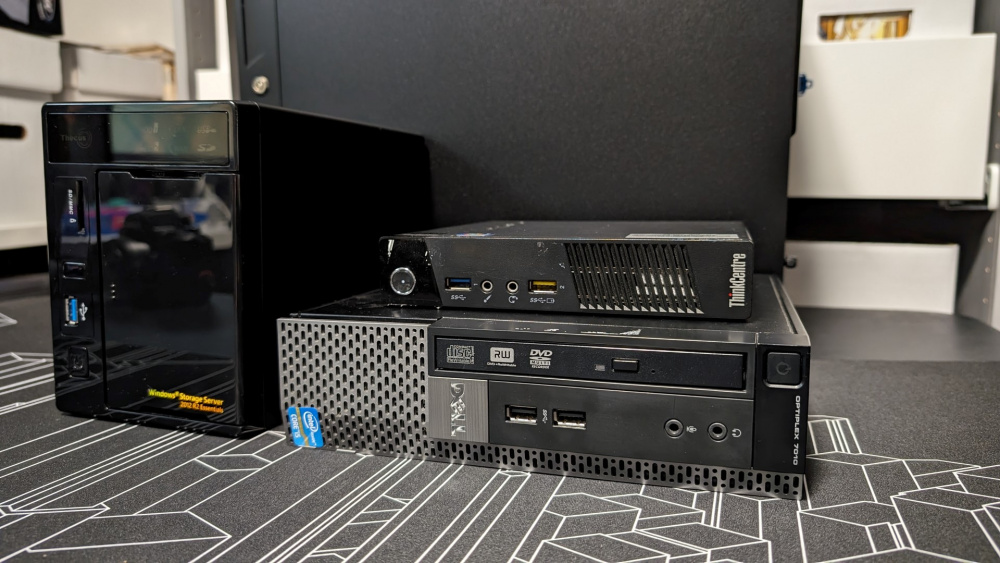Over the years I have accumulated quite the collection of PC hardware. Everything from cases to coolers, CPUs, GPUs, and more. It just comes with the territory when you work in IT, write reviews of hardware, and love computers in general. And over those years, I have set up a few different home servers to handle various tasks and duties that I deemed “necessary” – things like Plex and Minecraft servers, home automation hubs, private cloud services, to name a few. While everything in my cavalcade of random boxes was working just fine, none of them were really ideal for their assigned task. None of them felt like they ever had enough RAM, operating systems were all over the place with regards to versions, and the mess of power and network cables required to keep this group of machines running made troubleshooting a bit of a pain at times. I had always wanted to consolidate everything into a true “home server”, whatever that means. This last fall I finally made the move towards consolidating my setup, while adding the horsepower I had always imagined to my home server setup. This is the story of that process.
Goals
There were a few goals I had in mind when starting this project – consolidation, flexibility, and improved performance.
Consolidation – I wanted to retire hardware that was not up to snuff for the task at hand for a few reasons. Bringing everything into a centralized server would clean up power and network cabling, and also free up some plugs on my UPS. I don’t intend for this new server to provide a power savings, but in some cases, this could be a very real possibility, depending on the hardware being replaced, and what is taking its place.
Flexibility – Having worked with virtualization hardware and software in the past, I wanted to take advantage of some of those technologies with my new server. I wanted the ability to allocate resources quickly and easily, and if needed, shuffle things around to another server in the case of hardware failure in the new server. The options that virtualization offers are nearly limitless, but it can take a lot of funds to achieve that type of setup. That said, my single new server will still be able to offer a lot more options than the devices it is replacing.
Improved Performance – As I mentioned earlier, none of the old systems were really up to handling the task they were assigned. Weak CPUs, insufficient RAM, and in one case, a spinning disk as the OS drive, all added up to a home server lab that was functional, but not responsive enough for my liking. Plex felt a little slow at times, the Minecraft server had improved since its previous hardware iteration, but still felt a bit off, and the pre-built Windows Storage Server’s Intel Atom processor and 2GB of RAM was beginning to buckle under years of Windows updates.
Old Servers
To start things off, I want to provide a bit of information regarding what is now the “old” environment. None of the now retired gear was new when it was installed, other than the Thecus W2000+, a Windows Storage Server from 2015. All of the other systems were retired desktop systems that were headed for the e-waste pile. Here is a quick breakdown of the old systems, including their basic specifications and tasks.
Thecus W2000+ Home Server
CPU – Intel Atom D2701
RAM – 8GB, Upgraded from 4GB
Disk – 64GB SATA SSD, 2 x 500GB SATA HDD in a two-way mirror configuration in Storage Spaces
Tasks – TeamViewer client, torrent client, file storage
Lenovo Mini PC
CPU – Intel Core i3-4330
RAM – 8GB
Disk – 240GB SATA SSD
Tasks – Minecraft server
Dell OptiPlex 7010 SFF
CPU – Intel Core i5-3470S
RAM – 8GB
Disk – 500GB HDD
Tasks – VMware host (virtual machine hosting Plex and PRTG monitoring)
In addition to these systems, there are two NAS units in the environment. A six-bay Synology DS1618+ (reviewed here) is configured as the primary NAS in my home setup, while a two-bay ASUSTOR NAS is a local backup target for the Synology’s most important data. Don’t worry, there is also a scheduled task on the Synology to shoot encrypted backups to BackBlaze’s B2 platform. The remainder of the hosts on this network are various PCs, laptops, phones and tablets, game consoles, and IoT devices – your standard 2023 variety of devices.




